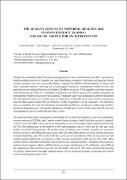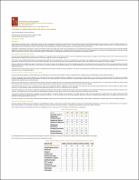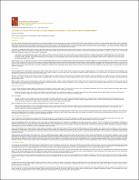The quality and use of maternal health care in Oyam district, Uganda:
| dc.contributor.author | Birungi, Sixtus | |
| dc.contributor.author | Odaga, John | |
| dc.contributor.author | Lochoro, John Peter | |
| dc.contributor.author | Santini, Stefano | |
| dc.contributor.author | Owiny, Vincent | |
| dc.contributor.author | De Vivo, Emmanuela | |
| dc.date.accessioned | 2019-11-04T06:56:00Z | |
| dc.date.available | 2019-11-04T06:56:00Z | |
| dc.date.issued | 2009-04-01 | |
| dc.identifier.citation | Birung, S. et al., 2009. The quality and use of maternal health care in Oyam district, Uganda: a baseline survey for an intervention. health policy and development, 7(1) pp. 35-47. | en_US |
| dc.identifier.uri | http://hdl.handle.net/20.500.12280/2441 | |
| dc.description.abstract | Despite the availability of technically sound approaches, maternal mortality and other reproductive health problems persist in Uganda and other developing countries. Utilisation of maternal health services remains very low, especially delivery attended by skilled birth attendants. In Oyam and other Ugandan districts smarting out of prolonged insurgency, reproductive health services are generally poorly utilised. Doctors with Africa-CUAMM, an Italian NGO, together with other partners and with funding from the EU, initiated a programme intended to improve the uptake and quality of reproductive health services in Oyam District. A baseline study was conducted in 2008 to document the initial pattern of use and quality of the existing maternal healthcare services in order to generate baseline data against which the performance of the programme will be evaluated. Its objectives were to establish the level of utilisation of maternal healthcare; the factors underlying mothers' health-seeking behaviour; the quality of maternal healthcare services; and to describe the outcome of pregnancies carried within the previous 5 years. The study had three major components: a household survey (1472 households); a survey of community resource persons (30 TBAs, and 9 senior women leaders); and a health facilities survey (1 hospital, 1 HC IV, and 5 HC IIIs). Government-owned facilities were the most prevalent and most utilised (by 84.7%). The median age of the mothers at the last pregnancy was 24 years and by that age, most mothers had had 3 pregnancies. At the first onset of labour, most women consulted an untrained friend or relative, and TBAs due to proximity. Overall, 41% of the deliveries in the district take place in health facilities, and 44% at the TBAs but 3.2% are not attended to. PNC services are not well utilised despite high levels of awareness of the presence and utility of the services (by 73%). Most mothers utilize injectable hormonal contraceptives and natural methods. Resistance from spouses and perceived negative effects of FP methods are major hindrances to FP utilisation. Over 90% of the pregnancies had a positive outcome for the mother and child. The study recommends focusing on quality improvement through implementation of the standard package of reproductive health services and support supervision. | en_US |
| dc.language.iso | en | en_US |
| dc.publisher | Uganda Martyrs University Press | en_US |
| dc.relation.ispartofseries | Health policy and development;volume 7 number 1 | |
| dc.subject | Maternal Health | en_US |
| dc.subject | Health Care | en_US |
| dc.subject | Maternal Health care | en_US |
| dc.subject | Quality - Maternal Health Care | en_US |
| dc.title | The quality and use of maternal health care in Oyam district, Uganda: | en_US |
| dc.title.alternative | a baseline survey for an intervention | en_US |
| dc.type | Article | en_US |





